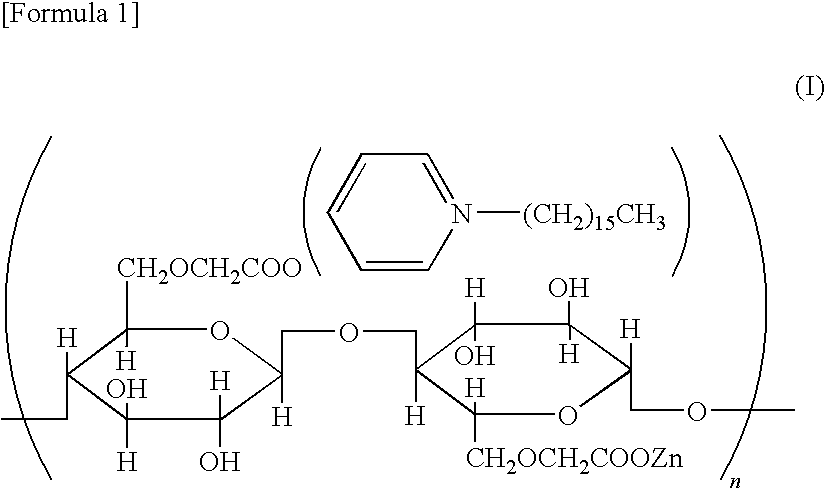Antimicrobial fiber and its production method, and antimicrobial fiber product comprising the antimicrobial fiber, its production method and regeneration method
a technology of antimicrobial fiber and antimicrobial fiber, which is applied in the direction of biocide, bandages, heterocyclic compound active ingredients, etc., can solve the problems of insufficient antimicrobial and deodorizing insufficient antimicrobial potency of the fiber, and insufficient durability of the antimicrobial fiber. , to achieve the effect of excellent antimicrobial durability, no skin irritation, and excellent antimicrobial
- Summary
- Abstract
- Description
- Claims
- Application Information
AI Technical Summary
Benefits of technology
Problems solved by technology
Method used
Image
Examples
example 1
[0134]A bandage of a spun-bond nonwoven fabric formed of a continuous fiber of cuprammonium rayon was dipped in an aqueous solution of sodium monochloroacetate and sodium hydroxide dissolved therein, then dewatered to a suitable dewatering ratio, and dried to be in an absolute dry condition, thereby obtaining a bandage in which a part of the hydroxy group of the cellulose fiber was sodium carboxymethylated.
[0135]Subsequently, the bandage was dipped and neutralized in an aqueous solution of zinc sulfate heptahydrate, acetic acid and sodium acetate dissolved therein, and simultaneously the sodium carboxymethyl group was converted into a zinc-carboxymethyl group. Afterwards, the remaining zinc sulfate, acetic acid and sodium acetate were removed by washing with water, and this was dried to give a bandage in which a part of the hydroxy group of the cellulose fiber was zinc-carboxymethylated.
[0136]Next, the above zinc-carboxymethylated bandage was dipped in an aqueous cetylpyridinium chl...
example 2
[0138]In the same manner as in Example 1 but using a nonwoven fabric of a lyocell fiber in place of the cuprammonium rayon nonwoven fabric and using silver nitrate in place of zinc sulfate heptahydrate, obtained was a bandage in which a part of the carboxy group bonding to the cellulose fiber (carboxy group of the carboxyalkylated cellulose fiber) was silver-carboxymethylated and another part was cetylpyridinium-carboxymethylated. The bandage was evaluated for various characteristics. The results are shown in Table 1.
example 3
[0139]In the same manner as in Example 1 but using a nonwoven fabric of a viscose rayon fiber in place of the cuprammonium rayon nonwoven fabric and using copper sulfate pentahydrate in place of zinc sulfate heptahydrate, obtained was a bandage in which a part of the carboxy group bonding to the cellulose fiber (carboxy group of the carboxyalkylated cellulose fiber) formed a copper salt and another part formed a cetylpyridinium salt. The bandage was evaluated for various characteristics. The results are shown in Table 1.
PUM
| Property | Measurement | Unit |
|---|---|---|
| water absorption | aaaaa | aaaaa |
| weight | aaaaa | aaaaa |
| wavelength | aaaaa | aaaaa |
Abstract
Description
Claims
Application Information
 Login to View More
Login to View More - R&D
- Intellectual Property
- Life Sciences
- Materials
- Tech Scout
- Unparalleled Data Quality
- Higher Quality Content
- 60% Fewer Hallucinations
Browse by: Latest US Patents, China's latest patents, Technical Efficacy Thesaurus, Application Domain, Technology Topic, Popular Technical Reports.
© 2025 PatSnap. All rights reserved.Legal|Privacy policy|Modern Slavery Act Transparency Statement|Sitemap|About US| Contact US: help@patsnap.com

